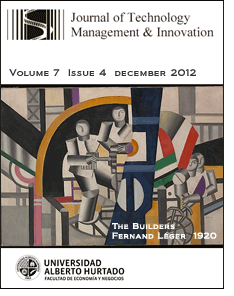A Tuned Value Chain Model for University Based Public Research Organisation. Case Lut Cst.
DOI:
https://doi.org/10.4067/S0718-27242012000400013Keywords:
Value chain, public research organization, research collaborationAbstract
The Porter´s value chain model was introduced for strategic business purposes. During the last decades also Universities and University based institutes have started to use actions similar to private business concepts. A University based institute is not independent actor like company but there are interest groups who are expecting them to act like they would be. This article discusses about the possibility of utilize tuned value chain to public research organizations (PRO). Also the interactions of tuned value chain model to existing industrial network are discussed. The case study object is the Centre for Separation Technology (CST) at Lappeenranta University of Technology (LUT) in Finland.Downloads
References
AURANEN, O., Nieminen, M. (2010). University research funding and publication performance – An international comparison, Research Policy, 39, 822-824.
BARNES, T., Pashby, I., Gibbons, A. (2002). Effective University – Industry Interaction: A Multi-case Evaluation of Collaborative R&D Projects, European Management Journal, 20 (3), 272–285.
BIN, A., Salles-Filhoa, S. (2012). Science, Technology and Innovation Management: Contributions to a Methodological Framework, J.Technol. Manag. Innov., 7 (2), 73-85.
BOARDMAN, C., Corley, E. (2008). University research centers and the composition of research collaborations, Research Policy, 37 (5), 900-913.
BOARDMAN, C., Bozeman, B. (2007). Role strain in university research centers, The Journal of Higher Education, 78 (4), 430-463.
DALPÉ, R., Ippersiel, M-P. (1999). Public Research Organizations in the Knowledge Infrastructure, http://www.utoronto.ca/isrn/publications/WorkingPapers/Working99/Dalpe99_PRO.PDF
ETZKOWITZ, H. (2003). Research groups as ‘quasi-firms’: the invention of the entrepreneurial university, Research Policy, 32 (1), 109-121.
FRITSCH, M., Schwirten, C. (1999). Enterprise University Co-operation and the Role of Public Research Institutions in Regional Innovation Systems, Industry and Innovation, 6 (1), 69-83.
GARDNER, P.L., Fong,A.Y., Huang, R.L. (2010). Measuring the Impact of Knowledge Transfer from Public Research Organizations: A Comparison of Metrics Used Around the World, International Journal of Learning and Intellectual Capital, 7 (3/4), 318 - 327.
GRUNERT, K., Jeppesen, L.F., Jepersen, K.R., Sonne, A-M. (2005). Market orientation of value chains. A conceptual framework based on four case studies from the food industry, European Journal of Marketing, 39 (5/6), 428-455.
HANSEN, M.T., Birkinshaw, J. (2007). The Innovation Value Chain, https://blog.itu.dk/KMP-E2008/files/2008/08/theinnovationvaluechain.pdf
JOLY, P.B., Mangematin, V. (1996). Profile of laboratories, industrial partnerships and organization of R&D: the dynamics of relations with industry in a large research organization, Research Policy, 25 (4), 901-922.
JOHNSON, W.H.A., Johnston, D.A. (2004). Organisational knowledge creating processes and the performance of university-industry collaborative R&D projects, International Journal of Technology Management, 27 (1), 93 – 114.
KANNEGIESSER, M. (2008).Value Chain Management in the Chemical Industry: Global Value Chain Planning of Commodities, Heidelberg: Physica-Verlag.
KAUFMANN,A.,Tödtling, F. (2001). Science-industry interaction in the process of innovation: the importance of boundary crossing between systems, Research Policy, 30, 791-804.
KENNEY, M. (1987). The Ethical Dilemmas of University-Industry Collaborations, Journal of Business Ethics, 6, 127-135.
LÄHTEENMÄKI-SMITH, K., Hyytinen, K., Kutinlahti, P., Konttinen, J., (2006). Research with an impact. Evaluation practises in public research organisations. VTT Research notes 2336. http://www.vtt.fi/inf/pdf/tiedotteet/2006/T2336.pdf
LANDRY, R., Amara, N., Pablos-Mendes, A., Shademani, R., Gold, I. (2006). The knowledge-value chain: a conceptual framework for knowledge translation in health, Bulletin of the World Health Organization, 84 (8), 592-602.
LANDRY, R., Amara, N. (1998). The impact of transaction costs on the institutional structuration of collaborative academic research, Research Policy, 27, 901–913.
LEE, Y.S. (1996). Technology transfer' and the research university: a search for the boundaries of university-industry collaboration 1, Research Policy, 25, 843-863.
LEYDESDORFF, L., Etzkowitz, H. (1996), Emergence of a Triple Helix of university-industry-government relations, Science and Public Policy, 23, 279-286.
LEYDESDORFF, L. and Etzkowitz, H. (2000),The dynamics of innovation: from National Systems and ‘Mode 2’ to a Triple Helix of university-industry-government relations, Research Policy, 29 (2), 109-123.
LEYDESDORFF, L., & Meyer, M. (2010). The Decline of University Patenting and the End of the Bayh-Dole Effect. Scientometrics, 83(2), 355-362.
LEYDESDORFF, L. (2012). The Triple Helix of University- Industry-Government Relations, http://www.leydesdorff.net/th12/th12.pdf
LÖBLER, M.L., Gomes da Silva, B., Pozzobon, D.M., Gomes, C.M. (2012). Strategic Orientation Towards Sustainable Innovation: A Case Study in a Brazilian University, J. Technol. Manag. Innov., 7 (2), 196-205.
LOIKKANEN, T., Hyytinen, K., Konttinen, J., (2011). Public research and technology organizations in transition – the case of Finland, Science,Technology & Society, 16 (1), 75-98.
MINDRUTA, D. (2008). Value creation in university-firm research collaborations: a matching approach, http://papers. ssrn.com/sol3/papers.cfm?abstract_id=1351904
NORDBERG, M., Campbell, A., Verbeke, A. (2003). Using customer relationships to acquire technological innovation. A value-chain analysis of supplier contracts with scientific research institutions. Journal of Business Research, 56, 711-719.
ORLIKOWSKI,W. J., Barley, S.R. (2001).Technology and Institutions:What Can Research on Information Technology and Research on Organizations Learn from Each Other? Management Information Systems Quarterly, 25 (2), 145-165.
PERKMANN, M., Walsh, K. (2007). University-industry relationships and open innovation: towards a research agenda, International Journal of Management Reviews, vol. 9 (4), 259-280.
PORTER, M. (1985). Competitive Advantage: Creating and Sustaining Superior Performance, New York, NY, The Free Press.
PRAJOGO, D.I., McDermott, P., Goh, M. (2008). Impact of value chain activities on quality and innovation, International Journal of Operations & Production Management, 28 (7), 615-635.
ROHRBECK, R., Arnold, H., M. (2006). Making university- industry collaboration work – a case study on the Deutsche Telekom Laboratories contrasted with findings in literature, ISPIM 2006 Conference “Networks for Innovation” 11th-14th June 2006, Athens, Greece.
ROPERA, S., Dub, J., Loveb, J.H. (2008). Modelling the innovation value chain, Research Policy, 37, 961–977.
SANTORO, M.D., Betts, S.C. (2002). Making industry-University partnerships work, Research Policy, 31 (7), 1163-1180.
STARBUCK, E. (2001). Optimizing University research collaborations, Research Technology Management, 44 (1), 40-45.
UGHETTO, E. (2007). Foresight as a triple helix of industry, university and government relations, Foresight, 9 (5), 14-22.
WALTERS, D., Lancaster, G. (2000). Implementing value strategy through the value chain, Management Decision, 38 (3), 160 – 178.
Downloads
Additional Files
Published
How to Cite
Issue
Section
License
Copyright (c) 2012 Journal of Technology Management & Innovation

This work is licensed under a Creative Commons Attribution-ShareAlike 4.0 International License.







